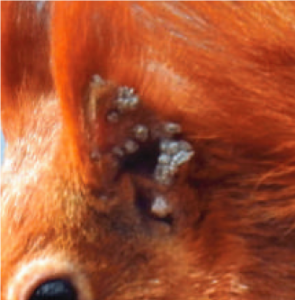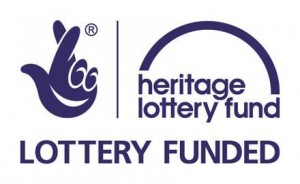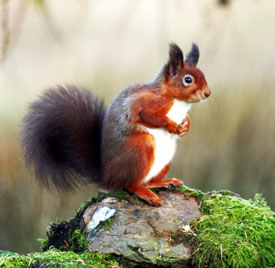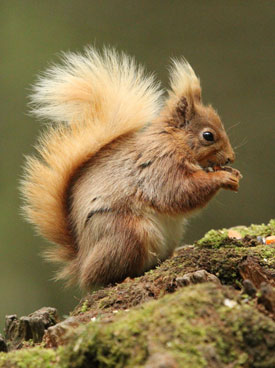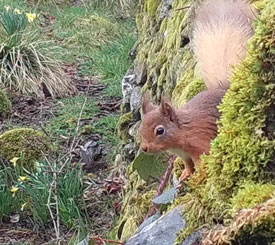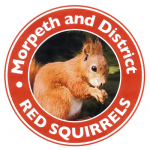 In 2015, the MADRS grey control team removed over 1100 greys from our patch and another 720 were removed in 2016. If a third of these were female and you think about each having 2 breeds with 3-4 young per season….well, it makes for a heck of a lot of greys damaging trees, predating on bird eggs and fledgelings and obviously spreading the killer squirrel pox virus to our native reds. As always, it is this essential work that is the greatest contributing factor to helping to safeguard our endangered native reds. We keep stressing that this is not a side of red conservation that is taken lightly. It is the necessary to ensure the survival of the reds. There is much talk of a grey squirrel infertility drug being researched but the fact is this is going to be a great many years away. Until that time, the concerted effort of our grey control team and everyone who reports sightings and people who monitor a trap in their garden, is the only saviour for the red squirrel. Read more>>
In 2015, the MADRS grey control team removed over 1100 greys from our patch and another 720 were removed in 2016. If a third of these were female and you think about each having 2 breeds with 3-4 young per season….well, it makes for a heck of a lot of greys damaging trees, predating on bird eggs and fledgelings and obviously spreading the killer squirrel pox virus to our native reds. As always, it is this essential work that is the greatest contributing factor to helping to safeguard our endangered native reds. We keep stressing that this is not a side of red conservation that is taken lightly. It is the necessary to ensure the survival of the reds. There is much talk of a grey squirrel infertility drug being researched but the fact is this is going to be a great many years away. Until that time, the concerted effort of our grey control team and everyone who reports sightings and people who monitor a trap in their garden, is the only saviour for the red squirrel. Read more>>
Category: News & Newsletters
Westmorland Red Squirrels – Spring 2017
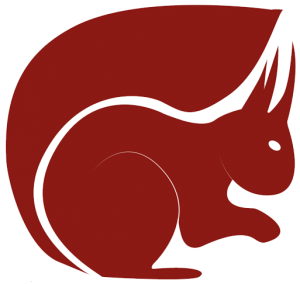 If you’re new to red squirrels, all the various organisations involved in red squirrel conservation must seem baffling – even those of us who’ve been involved for many years find it hard to keep up with developments. The UK Squirrel Accord is the most recent organisation at the national, policy-making level and we’re pleased to report here that the voluntary groups are in the process of gaining recognition in that forum. Regionally, the Red Squirrels Northern England (RSNE) project will still be processing our cull and sightings data and continuing their monitoring programme, but their capacity to provide practical conservation help is now very much reduced owing to a lack of funding. Red Squirrels United is the new UK-wide red squirrel project that you might hear about in the media, but unfortunately for us the project doesn’t specifically include Cumbria. It’s therefore more important than ever for us to work closely with our fellow voluntary groups through our membership of Northern Red Squirrels Cumbria in order to keep Cumbria’s red squirrels high on the conservation agenda and in the public eye. Read more>>
If you’re new to red squirrels, all the various organisations involved in red squirrel conservation must seem baffling – even those of us who’ve been involved for many years find it hard to keep up with developments. The UK Squirrel Accord is the most recent organisation at the national, policy-making level and we’re pleased to report here that the voluntary groups are in the process of gaining recognition in that forum. Regionally, the Red Squirrels Northern England (RSNE) project will still be processing our cull and sightings data and continuing their monitoring programme, but their capacity to provide practical conservation help is now very much reduced owing to a lack of funding. Red Squirrels United is the new UK-wide red squirrel project that you might hear about in the media, but unfortunately for us the project doesn’t specifically include Cumbria. It’s therefore more important than ever for us to work closely with our fellow voluntary groups through our membership of Northern Red Squirrels Cumbria in order to keep Cumbria’s red squirrels high on the conservation agenda and in the public eye. Read more>>
Non-lethal ways of reducing invasive grey squirrel populations
Work is being stepped up to develop an oral contraceptive specifically for controlling grey squirrels, which are such a threat to our red squirrels. A report in The Independent summarises the next phase of work by the Government’s Animal and Plant Health Agency to develop the vaccine and design grey-only traps. More details here: http://www.independent.co.uk/environment/prince-charles-squirrels-nutella-sterilise-plans-backs-grey-red-a7597481.html . The same story is covered in The Times: http://www.thetimes.co.uk/article/prince-of-wales-backs-mass-sterilisation-of-grey-squirrels-ncgstkh28?shareToken=c3be20f11407765b02ac3e18fed007f3
Your Red Squirrels Need You!
Northern Red Squirrels welcomes the recent call for a national army of volunteers to save our red squirrels. More details here: http://www.wildlifetrusts.org/news/2017/02/24/vital-volunteers-needed-save-our-last-red-squirrel
If you are interested in becoming a volunteer for Northern Red Squirrels, check the NRS Groups section above to see if there is a group near you.
P&DRSG – Winter Newsletter 2016
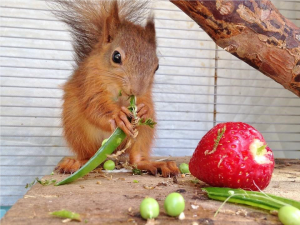
Maybelle is free again
It gives us great pleasure to anounce the safe release of Maybelle the red squirrel back into the wilds of Haweswater. Maybelle was rescued by Jerry & Sarah back in May after she was found wandering in the grounds of Haweswater Hotel. After plenty of TLC, the tiny red squirrel kitten was strong enough to fend for herself and quickly learned how to use a squirrel feeder and enjoyed cosy nights in her own nesting box. Read more>>
Morpeth & District Red Squirrels – Winter 2016
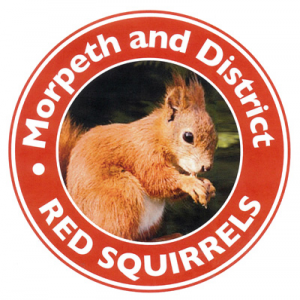 By the end of October the MADRS grey control team had passed the 600 mark of grey squirrels removed from our patch. It is this essential work that is the greatest contributing factor to helping to safeguard our endangered native reds. However, without the support of the public who report sightings and also from private households who monitor traps in their gardens, we would not be able to achieve these results. As always it is the ‘many a mickle meks a muckle’ approach that collectively produces these outstanding results. (‘Many a small makes a big’ for those who are struggling with my grannies old saying). Read more>>
By the end of October the MADRS grey control team had passed the 600 mark of grey squirrels removed from our patch. It is this essential work that is the greatest contributing factor to helping to safeguard our endangered native reds. However, without the support of the public who report sightings and also from private households who monitor traps in their gardens, we would not be able to achieve these results. As always it is the ‘many a mickle meks a muckle’ approach that collectively produces these outstanding results. (‘Many a small makes a big’ for those who are struggling with my grannies old saying). Read more>>
‘Squirrel’ published by ESI – Issue 33, November 2016
 Over the last year or so, we have noticed that some public sector officials seem to be concerned about the public perception issue of grey squirrel control and worried about a backlash. You would think that we are beyond such worries, but this could be due to rotation or retirement of staff and new staff coming into post and to counteract any concerns we decided to run our public perception survey after a 5 year holiday.
Over the last year or so, we have noticed that some public sector officials seem to be concerned about the public perception issue of grey squirrel control and worried about a backlash. You would think that we are beyond such worries, but this could be due to rotation or retirement of staff and new staff coming into post and to counteract any concerns we decided to run our public perception survey after a 5 year holiday.
I am delighted to report that awareness about the grey squirrel problem remains at broadly the same high level as before and support for grey squirrel control is still high. The full results are published later in the magazine… Read more>>
Westmorland Red Squirrels – Autumn 2016
 The unexpectedly low number of greys this year is very welcome, but presents us with our next challenge which is to keep it that way—by stopping any remaining greys from breeding back to their previous levels.
The unexpectedly low number of greys this year is very welcome, but presents us with our next challenge which is to keep it that way—by stopping any remaining greys from breeding back to their previous levels.
Adrian Vass, Director of the UK Squirrel Accord (UKSA), spoke at our AGM about a pilot scheme in the National Forest to put woodland owners in touch with volunteer shooters. In this issue, the article by Steve Bloomfield describes the scheme in more detail. If there’s sufficient interest in the scheme from local landowners we can take this further, so please get in touch to let me know your views. Read more>>
Wight Squirrel Project Newsletter – Autumn 2016
Leprosy in red squirrels is a recent discovery, not because it is a new disease but because nobody had picked up on it before. As it is widespread, from Scotland to the Isle of Wight and Brownsea, it’s likely it has been around in red squirrel populations for centuries. When I started working with red squirrels 25 years ago I noticed some had ‘warty ears’ but thought no more of it as they bred and seemed well in other respects. It takes a long time for the disease to progress so most animals would die of something else before the leprosy really took hold. Read more>>
Invitation from Red Squirrels Northern England
Red Squirrel Conservation Gatherings 2016
This has been a busy year and we would like to invite you to our Red Squirrel Conservation Gathering events for a chance to catch up and meet like-minded folks. There will be two events:
Red Squirrel Conservation Gathering – North West
Saturday 5th November, 10am – 2pm
Shap Wells Hotel
Lunch provided – please let us know of any dietary requirements when you book your tickets.
Please click here to see an agenda for the day and to book your tickets. Booking essential as places are limited.
Please contact Simon O’Hare by email or by calling 07748 269260 if you require further information.
Red Squirrel Conservation Gathering – North East
Saturday 12th November, 10am – 2pm
Stannington Village Hall
Lunch provided – please let us know of any dietary requirements when you book your tickets.
Please click here to see an agenda for the day and to book your tickets. Booking essential as places are limited.
Please contact Heinz Traut by email or by calling 07887782835 if you require further information.


